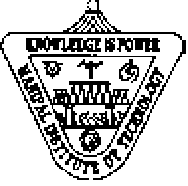Manipal University 2010 B.E Chemical Engineering University: ; : Computer Science and Engineering; Title of the : Engineering Chemistry ( ) - Question Paper
MANIPAL UNIVERSITY, MANIPAL
DEPARTMENT OF CHEMISTRY, MIT, MANIPAL
SECOND SEMESTER B.E DEGREE END SEMESTER exam
May 2010
SUBJECT: ENGINEERING CHEMISTRY (CHM 101/102)
Revised Credit System
Time : three hr Max.Marks: 50
Summary: This is a regular term ques. paper of May 2010 of the subject "Engineering Chemistry" which will help the students to expertise their knowledge and skills on this subject.
Reg.NO
MANIPAL UNIVERSITY, MANIPAL DEPARTMENT OF CHEMISTRY, MIT, MANIPAL SECOND SEMESTER BE DEGREE END SEMESTER EXAMINATION
May 2010
w$iih
y
INSPIRED BY LIFE

SUBJECT: ENGINEERING CHEMISTRY (CHM 101/102) Revised Credit System
Max.Marks: 50
Time : 3 hr
Note : Answer any five full questions. Draw neat and labelled diagram wherever necessary.
1.A. (i) What is stress corrosion? Explain the caustic embrittlement in mild steel boilers with reactions.
(ii) What are fuel cells? Explain the construction and working of H2 -O2 fuel cell.
1.B. (i) What is single electrode potential? Discuss the origin of single electrode potential. (ii) What are the advantages of electroless plating? Describe the electroless plating of copper.
1.C. Give reasons:
(i) Teflon is vulnerable to the reaction by hot alkali metals.
(ii) Impure metals corrode faster than pure metals under identical conditions.
( 4 + 4 + 2)
2.A. (i) What is anodic protection? Describe the anodic protection method. Mention its limitations.
(ii) Define the following terms:
a) Knocking b) Octane number c) Functionality d) Vulcanization 2.B. (i) Discuss the method of determining the G.C.V and N.C.V of a solid fuel.
(ii) A galvanic cell consists of iron electrode dipped in 0.1 M FeSO4 and silver electrode dipped in 0.05 M AgNO3. Write the cell representation, cell reaction and calculate the emf of the cell at 298 K. Given that the standard reduction potential of iron and silver electrode are 0.44 V and 0.80 V respectively.
2.C. (i) Give reason: Lead acid battery acts as voltaic and electrolytic cell whereas dry cell acts only as voltaic cell.
(ii) Draw the structure of cis and trans forms of polyisoprene.
( 4 + 4 + 2)
3.A. (i) Describe the construction and working of Ni- Cd battery with reactions. What are the advantages of this battery over lead acid battery?
(ii) What is cracking of petroleum? Give an example.
(iii) The following data were obtained in Boys calorimeter experiment.
Volume of gas used = 0.1 m3 at STP
Gross calorific value = 3250 kcal/kg Net calorific value = 3105 kcal/kg Latent heat of steam = 580 kcal/kg
Calculate the weight of steam condensed during the experiment.
3.B. (i)Explain the construction and working of saturated calomel electrode. Mention its advantages.
(ii) Give the method of synthesis and properties of epoxy resin.
(iii) Why does the emf of a concentration cell become zero at certain point of its working?
3.C. Explain how the following factors affect the rate of corrosion.
(i) Hydrogen overvoltage (ii) Polarization (4 + 4 + 2)
Page 1 of 2
(i) Describe the manufacture of water gas and mention its two important uses.
(ii) Discuss the effect of organic additives on the nature of electrodeposits.
Distinguish the followings.
4.B.
4.C.
5.A.
5.B.
5.C.
6.A. 6.B.
(a) Galvanization and tinning process (b) Concentration and kinetic polarization
(c) Bulk and solution polymerisation (d) Galvanic and electrochemical series What is glass transition temperature? Explain any three factors that affect Tg.
( 4 + 4 + 2)
(i) What are ion selective electrodes? Give the construction of glass electrode and describe the determination of pH of a solution by using it.
(ii) What is a standard cell? Explain the potentiometric method of measurement of emf of a cell.
(i) Explain the synthesis, properties and applications of styrene-butadiene rubber.
(ii) What is reforming of petroleum? Give any two reforming methods.
(iii) State and explain the type of corrosion occurring in the following example.
A steel pipe connected to copper plumbing.
(i) Polymer molecules with different degree of polymerization such as 500, 750, 850 and 1100 are mixed in molecular ratio 1: 2: 3: 4 in a sample of high polymer of styrene. Calculate the number average and weight average molecular weights.
( 4 + 4 + 2)
Derive the mathematical expressions for AG, AH and AS for a galvanic cell.
(i) A sample of coal was analysed as follows. Exactly 2.5 g was weighed into a silica crucible. After heating for one hour at 110 0C the residue weighed 2.415 g. The crucible was covered with a vented lid and strongly heated for seven minutes at 950 0C. The residue weighed 1.528 g. The crucible was then heated without the cover until a constant weight was obtained. The last residue was found to weigh 0.245 g. Calculate the percentage of moisture content, volatile mater, ash and fixed carbon in the above sample.
(ii) Briefly explain the effect of structure of polymer on chemical resistance and crystallinity.
Give reasons for the following:
6.C.
(i) High percentage of volatile matter is undesirable in a fuel.
(ii) AG is positive in an electrolytic cell.
( 4 + 4 + 2 )
Page 2 of 2
|
Attachment: |
| Earning: Approval pending. |
